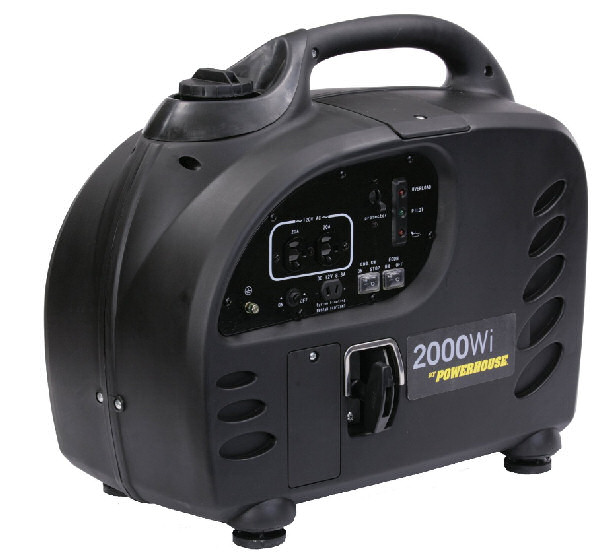
Inverter GeneratorAn inverter generator is to conventional generators what a smartphone is to Mr. Bell's first telephone: It's a giant leap forward in electircity generation! About 8 years ago, Honda brought to market a new inverter generator. It was smaller, lighter, quieter and more efficient than conventional generator models: For starters, inverter generators are running at about half the noise level or less, compared to old style copper coil generators. Then - and that is very interesting - the new generation inverter generators also consume a lot less fuel, as they are able to adapt the power to the actual consumption in electircity. Old style portable generators have to run at contantly high speed to produce the electricity. I'm sure you are starting to ask yourself, if such a nifty generator might not be a good thing to have for yourself? A storm or other mishap can cut the electricity to your home and you would be prepared! Inverter generators are small, quiet and very efficient machines that produce enough electricity to run tools at a remote job site, that can keep the lights, microwave and even the TV on during a power cut.
What an Inverter Generator can be used for:Let's first have a look what an inverter generator is technically: There are four major advantages over the old style portable generators:
Initially inverter generators were mostly sold to campers. There are large inverter generator models (3'000 to 6'000 watts) that can even start up a 15'000 btu air conditioner and supply enough power to all the other appliances in a decent size motor home. Middle sized inverter generators (2'000 - 3'000 watts) should be able to start 13'500 btu air conditioners and provide enough current for a samller motorhome or travel trailer. Finally the small inverter gererators (1'000 to 2'000 watts) are a perfect choice for camping with a tent or a pop-up trailer, providing enough elctricity for lights, TV, microwave and other small kitchen tools. Nowadays they are used on construction sites (low noise = workers can start very early in the morning and not get complaints because of the noise) where gefore the old style generators with their lawn mower noise prevented early starts. Homeworkers are using them to power their electrical tools away from outlets, and mayn home owners have one as a backup generator in case of power outages. The wide possibilities and the good acceptance in the market have led to lower prices for the initially quite expensive new machines. They are still a lot more expensive than conventional generators, but especially the nois advantage and to a certain point the fuel efficiency make many buyers decide that they are the better choice.
How an inverter generator works:Generators convert mechanical energy to electricity thanks to a phenomenon called electromagnetic induction. Voltage is induced by the movement of a conductor, usually coils of copper wire, that rotate inside a magnetic casing. The mechanical energy used by home generators normally comes from a small motor that runs on gasoline. In a conventional generator, every engine rotation produces one sine wave of AC power. For the electricity to produce the standard American 120-volt, 60-Hz electricity, the engine must run at a constant speed of 3600 rpm, regardless of the load.
An inverter generator is designed to produce more AC electrical energy per motor rotation but not in a form that can be used directly. Therfore this raw electricity must first be transformed into DC power. An electronic inverter module then transforms the DC power back into standard 120-volt, 60-Hz AC power. The advantage of this system is that the motor only needs to run at speeds that match the required load and is therefore quieter and more fuel-efficient.
What to look for when buying an inverter generator:Event though inverter generators are less noisy, this can differ from model to model and different brands will have different characteristics. It's therefore a good idea to check out a few models and brands before you buy. Power output: You need to consider the power-up consumption of your tools and appliances you want to run on the inverter generator. A good list can be found here. If you use the generator smartly, you only need to consider the highest start wattage and then add other appliances once the first one has gone into normal run mode. Noise levels: Make sure you measure under the same load and at the same distance. Get an app for your smartphone that measures decibels (i.e. the free Sound Level Meter in the Android Google Apps store). Don't forget that decibels show exponentially increasing noise. From 60 to 90 decibels the nois increase is 1000fold! Weight: Make sure you actually pick up the unit and walk a few meters with it. That will give you a good feel if you are comfortable with the weight. Control panel: A well designed panel will give you all the information about the voltage output, the frequency(Hz) and hours of operation. It should also have warning LEDs when overloaded. Some generators also have a switch to boost the output for a short time, when needed. Receptacles: Make sure you have what you need, obviously two receptacles are better! Gas tank: Make sure it's easy to access and the opening is large enough to comfortably fill up.
|
Generators Home Generator Features Generator Engine Generator Power Needs Resources Site Map
